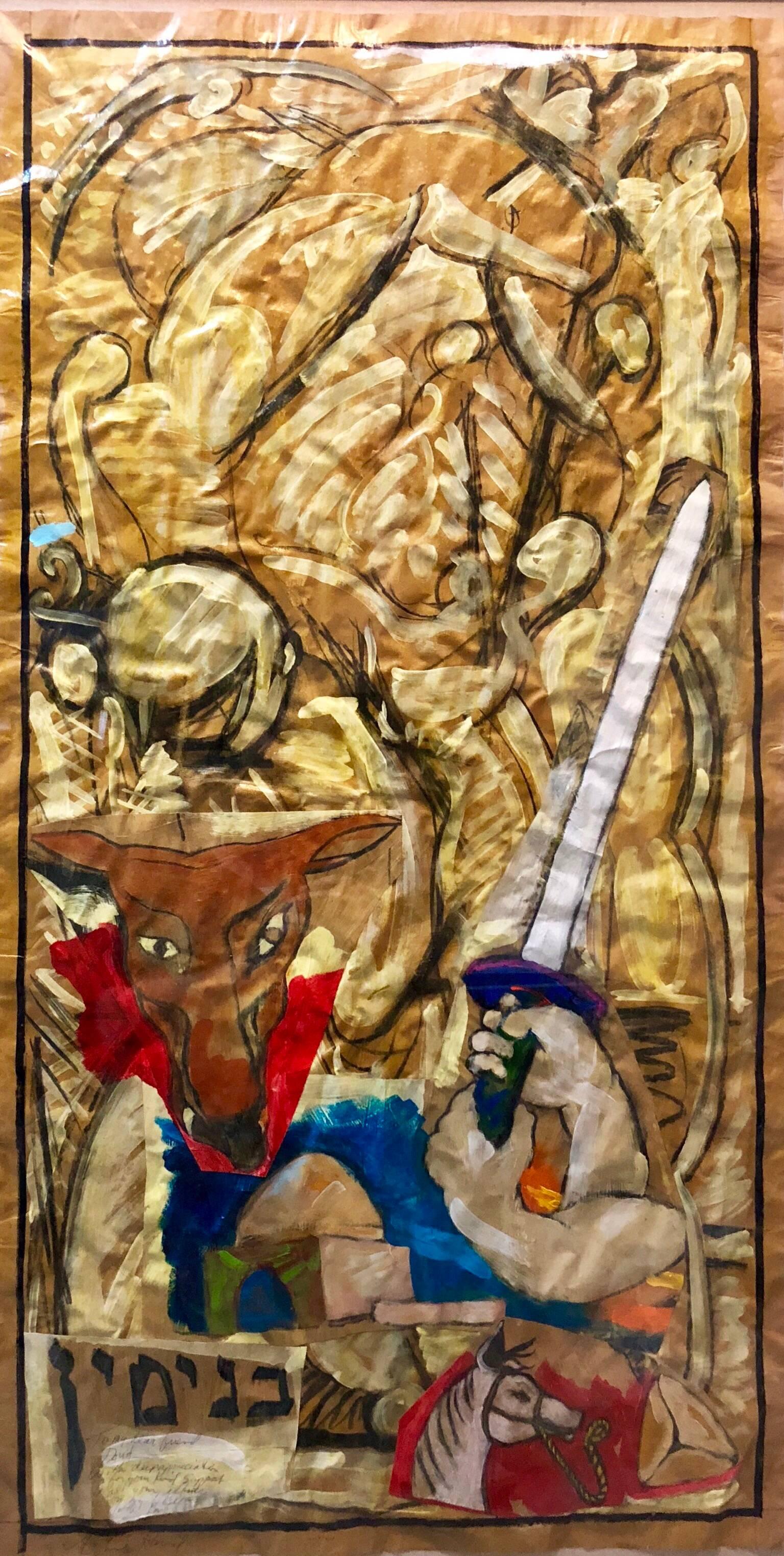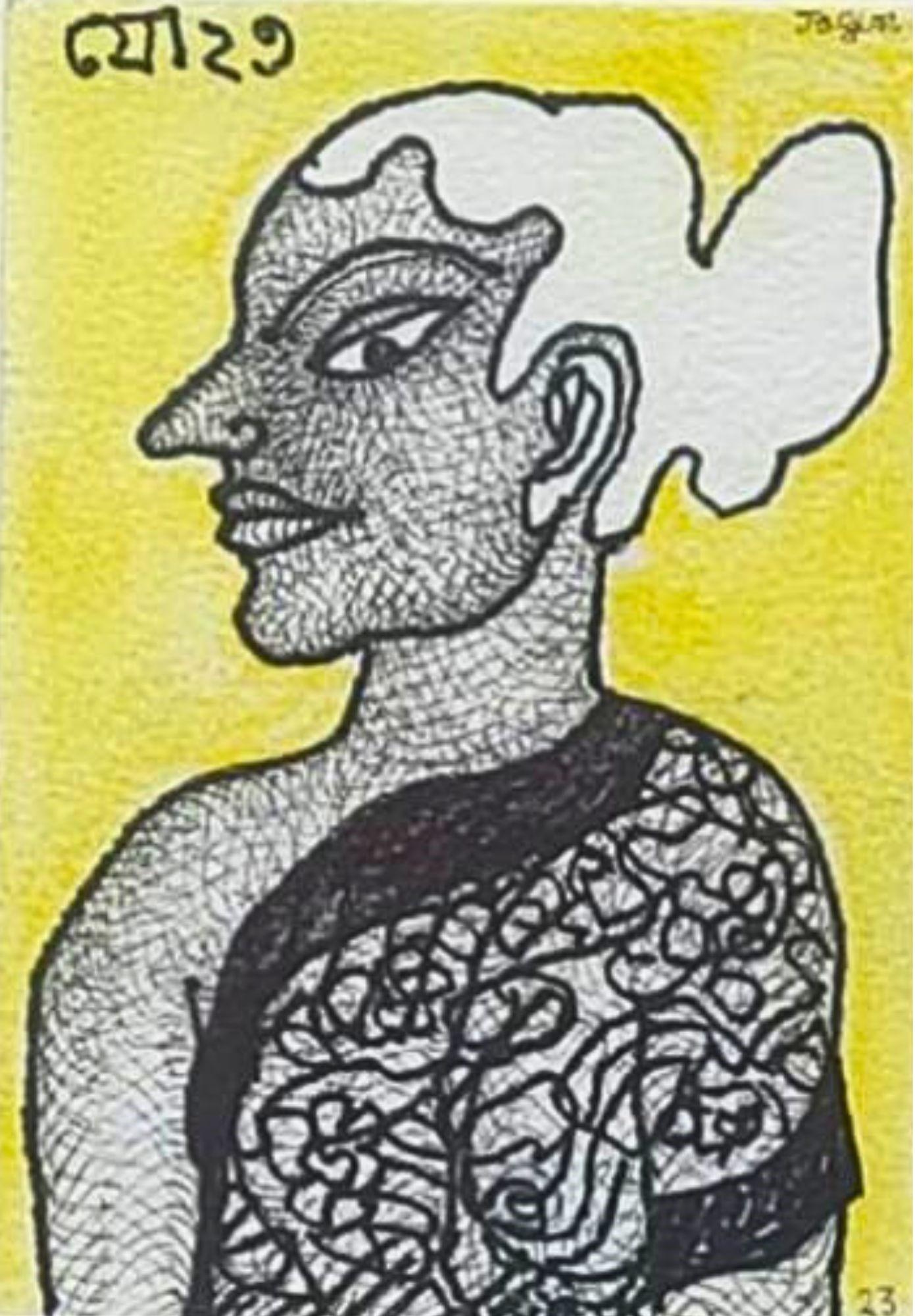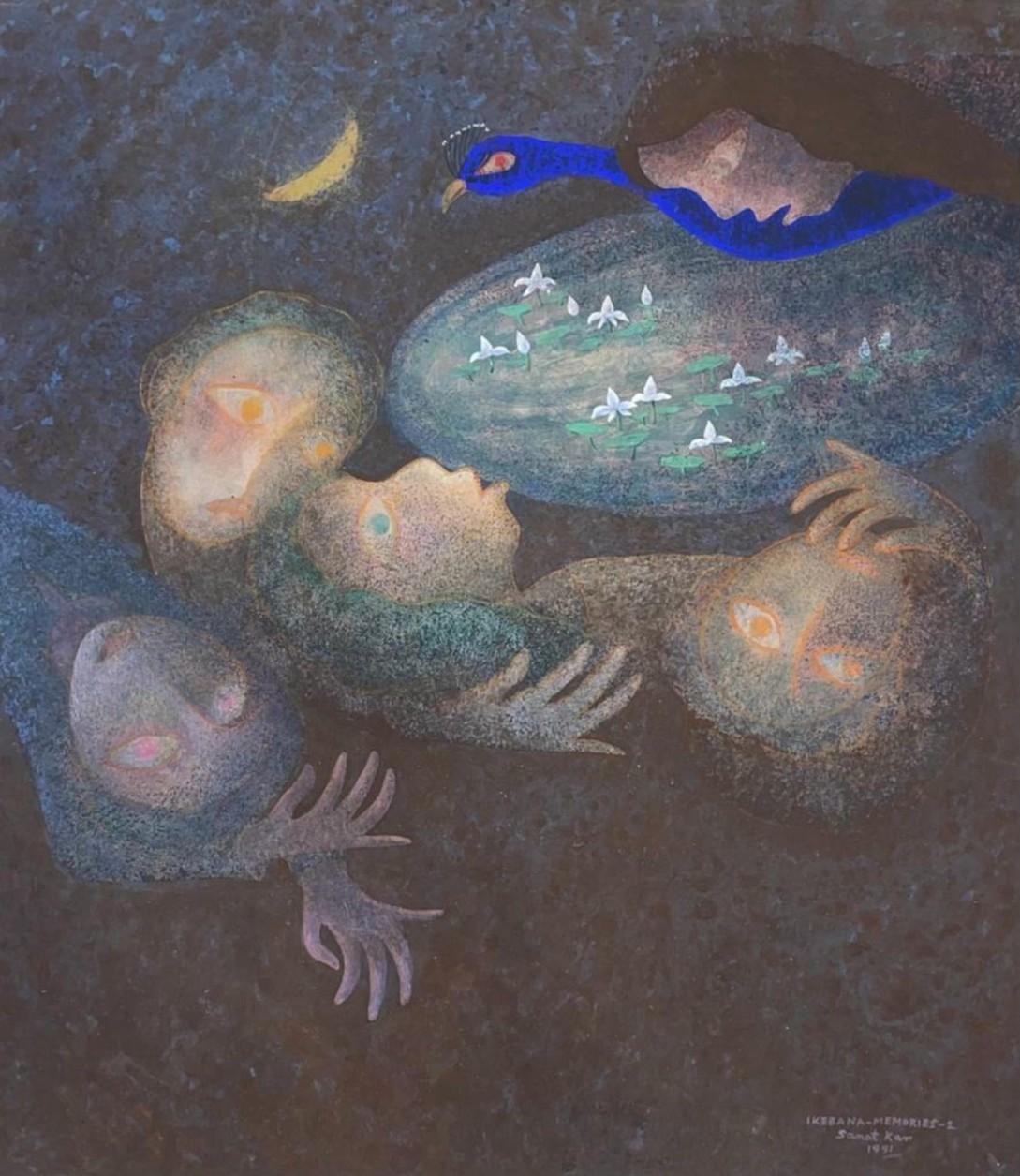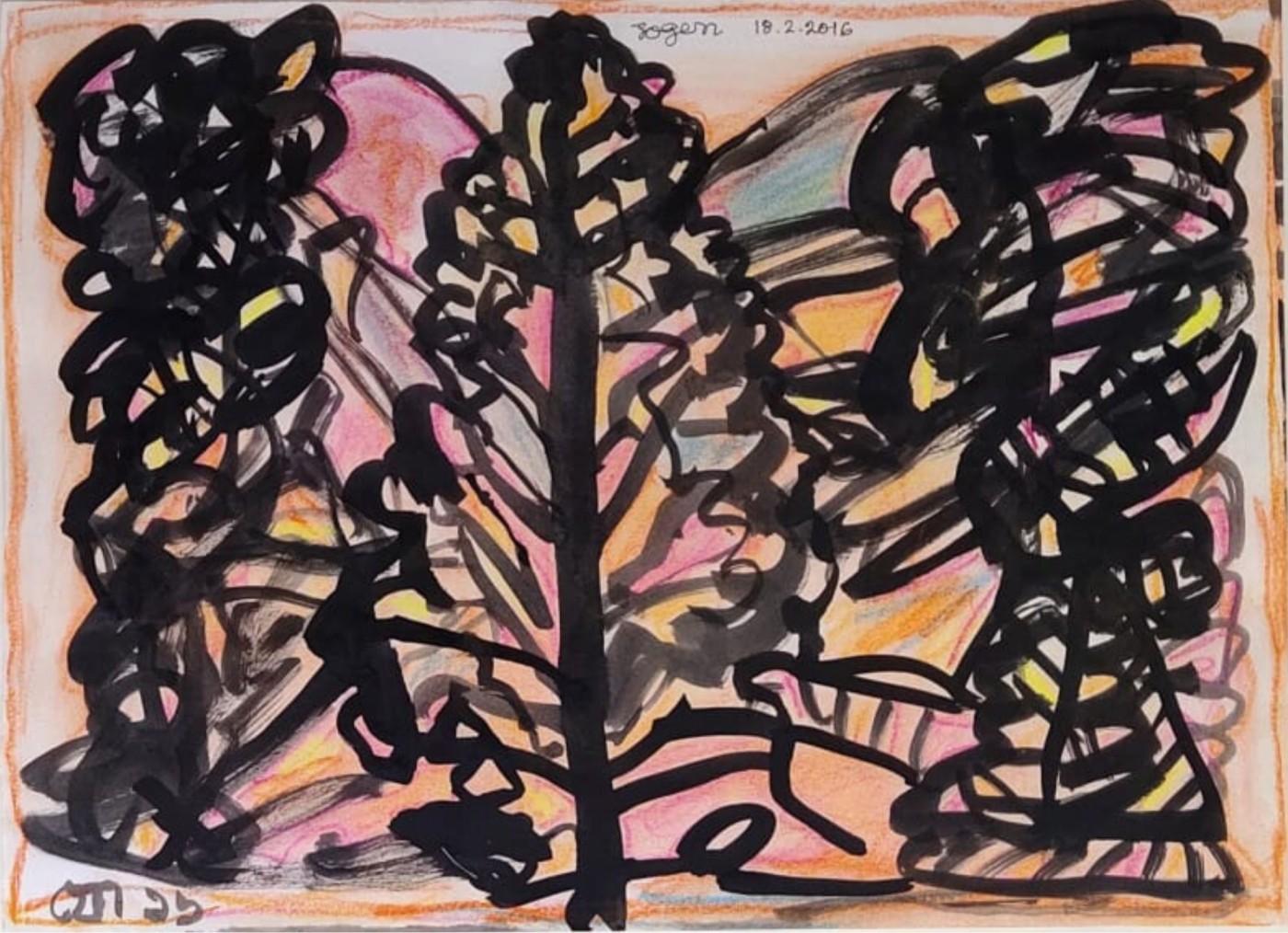Items Similar to Circus Jumpers #2 (Equestrians) mixed media painting by Jon Corbino
Want more images or videos?
Request additional images or videos from the seller
1 of 10
Jon CorbinoCircus Jumpers #2 (Equestrians) mixed media painting by Jon CorbinoCirca 1950
Circa 1950
About the Item
Signed "Corbino" lower left
Inscribed on frame by artist with artist's address in Rockport, MA
Titled by artist on inscription verso.
Provenance: Oelschlaeger Gallery, Chicago, IL. (label verso)
From the artist's July 11, 1964 NYT obituary:
Jon Corbino, painter, whose canvases are represented in 35 museums and galleries, died yesterday at the age of 59.
Mr. Corbino's work, freely described as romantic realism, was characterized by technical skill, vivid color, and scenes of action and movement. Thematically and technically, he was influenced in his early days by the works of DeIacroix and 17century Spanish painters.
He flourished in the nineteenthirties and forties when his dramatic canvases responded to the intellectual climate of those decades. His paintings continued to find many purchasers in the Middle West and Florida until his death.
Commenting on an exhibition of Mr. Corbino's works in 1959, one critic said:
“Romanticism bounds back in Jon Corbino's high spirited circus paintings. Horses and riders, acrobats and dancers perform the liveliest feats in these pictures.
“As compositions they are rather untidily put together, but they show real strength in the representation of movement. Color is, as always with Corbino, warm, pretty, and extremely sweet”
Mr. Corbino was born in Vittorio, Italy, April 3, 1905. At the age of 8 he was brought to the United States, where he attended the Ethical Culture School and the Art Students League here and the Pennsylvania Academy of Fine Arts. He was awarded Guggenheim Fellowships in 1936 and 1937.
Mr. Corbino's forceful, dramatic style won him early recognition and popularity, and oneman shows of his art were given with increased frequency. He received numerous prizes, awards, and medals. Among the museums and galleries that possess Corbino works are the Metropolitan Museum of Art, the Chicago Art Institute, the Whitney Museum, the Brooklyn Museum, the Carnegie Institute and the Brooks Memorial Art Museum in Memphis.
Mr. Corbino is survived by his widow, the former Marcia Norcross, and six children.
- Creator:Jon Corbino (1905 - 1964, American)
- Creation Year:Circa 1950
- Dimensions:Height: 18.5 in (46.99 cm)Width: 24 in (60.96 cm)
- Medium:
- Movement & Style:
- Period:
- Condition:
- Gallery Location:Hudson, NY
- Reference Number:
Jon Corbino
The following is based on information provided by Marcia Corbino, wife of Jon Corbino, and was updated with a publication list by Lee Corbino, daughter of the artist : Jon Corbino, N.A. (1905-1964) A highly acclaimed artist for heroic themes revealing the anxieties of America during the 1930s, Jon Corbino depicted disasters such as wars and floods. These paintings were tributes to the perseverance of man against unknown forces of the universe. He was much admired for his skill in draftsmanship and brilliant, smoldering colors. He was also known for his love of horses, sometimes painting these powerful animals as mythic symbols from the Greek legends of the childhood. In addition, he painted the fantasy of the circus and the ballet, often from back stage where the performers were captured in a reflective moment. Jon Corbino was born in Vittoria, Sicily in 1905 and came to the United States with his parents at the age of 8. He grew up in New York City and attended the Ethical Culture Fieldston School on an art scholarship and then enrolled in the Art Students League. He received two Guggenheim Fellowships and was elected a member of the National Academy of Design in 1940. In 1941, he received the first grant awarded to a visual artist from the National Institute of Arts and Letters. The poet Stephen Vincent Benet made the presentation at Carnegie Hall, and in his commendation said that Corbino "has brought to American art rare gifts of color and design, and because of the honesty, richness and variety of his work." Corbino's work was also featured in three Venice Biennales. In 1966, a critic for the Chicago American wrote of a Corbino retrospective exhibition: "he painted people of the world-people on the beach, in the sun, in the moonlight. But he graced them with spirit, life, and movement that transcend the everyday." His work is represented in 64 U.S. museums as well as the Lotus Club, New York, NY; First National Bank of Chicago; Fine Arts Society, Sarasota, FL; Hallmark Cards, Inc., Kansas City, MO; Ringling College of Art and Design, Sarasota, FL; Georgetown University Library, Washington, D.C.; The United States Post Office, Long Beach, Long Island, NY; Town of Rockport, Massachusetts, Rockport, MA.
About the Seller
5.0
Vetted Seller
These experienced sellers undergo a comprehensive evaluation by our team of in-house experts.
Established in 1973
1stDibs seller since 2023
6 sales on 1stDibs
Typical response time: 1 hour
- ShippingRetrieving quote...Ships From: Hudson, NY
- Return PolicyThis item cannot be returned.
More From This SellerView All
- St. Atomic oil and tempera painting by Julio de DiegoBy Julio de DiegoLocated in Hudson, NYJulio De Diego’s Atomic Series paintings made an extraordinary statement regarding the shock and fear that accompanied the dawn of the nuclear age. In the artist’s own words, “Scientists were working secretly to develop formidable powers taken from the mysterious depths of the earth - with the power to make the earth useless! Then, the EXPLOSION! . . . we entered the Atomic Age, and from there the neo-Atomic war begins. Explosions fell everywhere and man kept on fighting, discovering he could fight without flesh.” To execute these works, De Diego developed a technique of using tempera underpainting before applying layer upon layer of pigmented oil glazes. The result is paintings with surfaces which were described as “bonelike” in quality. The forms seem to float freely, creating a three-dimensional visual effect. In the 1954 book The Modern Renaissance in American Art, author Ralph Pearson summarizes the series as “a fantastic interpretation of a weighty theme. Perhaps it is well to let fantasy and irony appear to lighten the devastating impact. By inverse action, they may in fact increase its weight.” Exhibited 1950 University of Illinois at Urbana "Contemporary American Painting" 1964 Marion Koogler McNay Art Institute, San Antonio, Texas This work retains its original frame which measures 54" x 36" x 2". About this artist: Julio De Diego crafted a formidable persona within the artistic developments and political struggles of his time. The artist characterized his own work as “lyrical,” explaining, “through the years, the surrealists, the social-conscious painters and the others tried to adopt me, but I went my own way, good, bad or indifferent.” [1] His independence manifested early in life when de Diego left his parent’s home in Madrid, Spain, in adolescence following his father’s attempts to curtail his artistic aspirations. At the age of fifteen he held his first exhibition, set up within a gambling casino. He managed to acquire an apprenticeship in a studio producing scenery for Madrid’s operas, but moved from behind the curtains to the stage, trying his hand at acting and performing as an extra in the Ballet Russes’ Petrouchka with Nijinsky. He spent several years in the Spanish army, including a six-month stretch in the Rif War of 1920 in Northern Africa. His artistic career pushed ahead as he set off for Paris and became familiar with modernism’s forays into abstraction, surrealism, and cubism. The artist arrived in the U.S. in 1924 and settled in Chicago two years later. He established himself with a commission for the decoration of two chapels in St. Gregory’s Church. He also worked in fashion illustration, designed magazine covers and developed a popular laundry bag for the Hotel Sherman. De Diego began exhibiting through the Art Institute of Chicago in 1929, and participated in the annual Chicago Artists Exhibitions, Annual American Exhibitions, and International Water Color Exhibitions. He held a solo exhibition at the Art Institute of Chicago in the summer of 1935. Though the artist’s career was advancing, his family life had deteriorated. In 1932 his first marriage dissolved, and the couple’s young daughter Kiriki was sent to live with friend Paul Hoffman. De Diego continued to develop his artistic vocabulary with a growing interest in Mexican art. He traveled throughout the country acquainting himself with the works of muralists such as Carlos Merida, and also began a collection of small native artifacts...Category
1940s American Modern Abstract Paintings
MaterialsMasonite, Oil, Tempera
- Inevitable Day – Birth of the Atom oil and tempera painting by Julio De DiegoBy Julio de DiegoLocated in Hudson, NYJulio De Diego’s Atomic Series paintings made an extraordinary statement regarding the shock and fear that accompanied the dawn of the nuclear age. In the artist’s own words, “Scientists were working secretly to develop formidable powers taken from the mysterious depths of the earth - with the power to make the earth useless! Then, the EXPLOSION! . . . we entered the Atomic Age, and from there the neo-Atomic war begins. Explosions fell everywhere and man kept on fighting, discovering he could fight without flesh.” To execute these works, De Diego developed a technique of using tempera underpainting before applying layer upon layer of pigmented oil glazes. The result is paintings with surfaces which were described as “bonelike” in quality. The forms seem to float freely, creating a three-dimensional visual effect. In the 1954 book The Modern Renaissance in American Art, author Ralph Pearson summarizes the series as “a fantastic interpretation of a weighty theme. Perhaps it is well to let fantasy and irony appear to lighten the devastating impact. By inverse action, they may in fact increase its weight.” Bibliography Art in America, April 1951, p.78 About this artists: Julio De Diego crafted a formidable persona within the artistic developments and political struggles of his time. The artist characterized his own work as “lyrical,” explaining, “through the years, the surrealists, the social-conscious painters and the others tried to adopt me, but I went my own way, good, bad or indifferent.” [1] His independence manifested early in life when de Diego left his parent’s home in Madrid, Spain, in adolescence following his father’s attempts to curtail his artistic aspirations. At the age of fifteen he held his first exhibition, set up within a gambling casino. He managed to acquire an apprenticeship in a studio producing scenery for Madrid’s operas, but moved from behind the curtains to the stage, trying his hand at acting and performing as an extra in the Ballet Russes’ Petrouchka with Nijinsky. He spent several years in the Spanish army, including a six-month stretch in the Rif War of 1920 in Northern Africa. His artistic career pushed ahead as he set off for Paris and became familiar with modernism’s forays into abstraction, surrealism, and cubism. The artist arrived in the U.S. in 1924 and settled in Chicago two years later. He established himself with a commission for the decoration of two chapels in St. Gregory’s Church. He also worked in fashion illustration, designed magazine covers and developed a popular laundry bag for the Hotel Sherman. De Diego began exhibiting through the Art Institute of Chicago in 1929, and participated in the annual Chicago Artists Exhibitions, Annual American Exhibitions, and International Water Color Exhibitions. He held a solo exhibition at the Art Institute of Chicago in the summer of 1935. Though the artist’s career was advancing, his family life had deteriorated. In 1932 his first marriage dissolved, and the couple’s young daughter Kiriki was sent to live with friend Paul Hoffman. De Diego continued to develop his artistic vocabulary with a growing interest in Mexican art. He traveled throughout the country acquainting himself with the works of muralists such as Carlos Merida, and also began a collection of small native artifacts...Category
1940s American Modern Abstract Paintings
MaterialsMasonite, Oil, Tempera
- The Magician oil and tempera painting by Julio de DiegoBy Julio de DiegoLocated in Hudson, NYJulio De Diego’s Atomic Series paintings made an extraordinary statement regarding the shock and fear that accompanied the dawn of the nuclear age. In the artist’s own words, “Scientists were working secretly to develop formidable powers taken from the mysterious depths of the earth - with the power to make the earth useless! Then, the EXPLOSION! . . . we entered the Atomic Age, and from there the neo-Atomic war begins. Explosions fell everywhere and man kept on fighting, discovering he could fight without flesh.” To execute these works, De Diego developed a technique of using tempera underpainting before applying layer upon layer of pigmented oil glazes. The result is paintings with surfaces which were described as “bonelike” in quality. The forms seem to float freely, creating a three-dimensional visual effect. In the 1954 book The Modern Renaissance in American Art, author Ralph Pearson summarizes the series as “a fantastic interpretation of a weighty theme. Perhaps it is well to let fantasy and irony appear to lighten the devastating impact. By inverse action, they may in fact increase its weight.” Exhibited 1964 Marion Koogler McNay Art Institute, San Antonio, Texas This work retains its original frame which measures 54" x 42" x 2" About this artist: Julio De Diego crafted a formidable persona within the artistic developments and political struggles of his time. The artist characterized his own work as “lyrical,” explaining, “through the years, the surrealists, the social-conscious painters and the others tried to adopt me, but I went my own way, good, bad or indifferent.” [1] His independence manifested early in life when de Diego left his parent’s home in Madrid, Spain, in adolescence following his father’s attempts to curtail his artistic aspirations. At the age of fifteen he held his first exhibition, set up within a gambling casino. He managed to acquire an apprenticeship in a studio producing scenery for Madrid’s operas, but moved from behind the curtains to the stage, trying his hand at acting and performing as an extra in the Ballet Russes’ Petrouchka with Nijinsky. He spent several years in the Spanish army, including a six-month stretch in the Rif War of 1920 in Northern Africa. His artistic career pushed ahead as he set off for Paris and became familiar with modernism’s forays into abstraction, surrealism, and cubism. The artist arrived in the U.S. in 1924 and settled in Chicago two years later. He established himself with a commission for the decoration of two chapels in St. Gregory’s Church. He also worked in fashion illustration, designed magazine covers and developed a popular laundry bag for the Hotel Sherman. De Diego began exhibiting through the Art Institute of Chicago in 1929, and participated in the annual Chicago Artists Exhibitions, Annual American Exhibitions, and International Water Color Exhibitions. He held a solo exhibition at the Art Institute of Chicago in the summer of 1935. Though the artist’s career was advancing, his family life had deteriorated. In 1932 his first marriage dissolved, and the couple’s young daughter Kiriki was sent to live with friend Paul Hoffman. De Diego continued to develop his artistic vocabulary with a growing interest in Mexican art. He traveled throughout the country acquainting himself with the works of muralists such as Carlos Merida, and also began a collection of small native artifacts...Category
1940s American Modern Abstract Paintings
MaterialsMasonite, Oil, Tempera
- The Lonely Road by William Charles PalmerLocated in Hudson, NYThe Lonely Road (1940) Tempera on panel 12" x 16" 19 1/2" x 23 1/2" x 1 1/2" framed Hand-signed "Palmer '40" lower center. Provenance: Midtown Galleries, New York, NY (labels verso...Category
Mid-20th Century American Modern Figurative Paintings
MaterialsPanel, Tempera
- Fish Story oil painting by Williams Charles PalmerLocated in Hudson, NYThis painting is illustrated in the Catalogue of the 1945 Encyclopedia Britannica Collection of Contemporary American Painting, p.84. Written and edited by Grace Pagano. "Painting ...Category
Mid-20th Century American Modern Figurative Paintings
MaterialsOil, Canvas
- The Junkman's Serenade oil painting by Gregorio PrestopinoBy Gregorio PrestopinoLocated in Hudson, NYThis work epitomizes Prestopino's interest in social realism which captures a quiet interlude in the everyday life of an "everyman." It also provides a contrast for our expectations as we view a tough, blue collar worker, with no one watching, as he sings a melody to the birds. In an original frame measuring 49" x 39" x 3.25" Provenance: Edith Halpert's Downtown Gallery (label verso from 13 w. 113th street, where the gallery was located from 1926 until 1939) Private collection, NYC, c. 1935 By descent About this artist: Born in Little Italy in 1907, Gregorio Prestopino first set out to become a sign painter as the son of New York City immigrants. Instead, his talent provided a life-changing scholarship to the National Academy of Design, and for five years he studied drawing under C. W. Hawthorne. He spent the summer of 1934 at the MacDowell Colony in Peterborough, New Hampshire. His deep involvement with the colony led him to later serve as its director in 1954. Much of Prestopino’s work was in the vein of social realism. During the 1940s and 1950s he became deeply invested in portraying everyday Manhattan and Harlem scenes. He first became interested in the Ashcan school at the National Academy of Design, and remained committed to an interest in working with urban scenes. His lively treatment of people and events revealed his affinity for sixteenth-century artist Pieter Breughel...Category
Early 20th Century Modern Figurative Paintings
MaterialsOil, Canvas
You May Also Like
- Tribe of Benjamin, Large Judaica Mixed Media Collage PaintingBy Archie RandLocated in Surfside, FLTribe of Benjamin, Biblical mural with wolf. I believe this is a study for a stained glass window. Untitled, mixed media on paper, signed lower left, inscribed "To my dear friend Dav...Category
1980s American Modern Figurative Paintings
MaterialsPaint, Paper, Mixed Media
- Untitled, Mixed Media on Paper by Artist Jogen Chowdhury "In StockBy Jogen ChowdhuryLocated in Kolkata, West BengalJogen Chowdhury Mixed Media on Paper 6 x 4.1 inches 2023 Style : He has immense contribution in inspiring young artists of India. Jogen Chowdhury had developed his individual styl...Category
2010s Modern Figurative Paintings
MaterialsPaper, Mixed Media
- Ikebana Memories-2, Mixed Media on Paper "In Stock"By Sanat KarLocated in Kolkata, West BengalSanat Kar - Ikebana Memories-2 22 x 19 inches (unframed size) Mixed Media on Paper 1991 Style: Majority of Sanat Kar's works are surrealistic and have a curious dream-like appearan...Category
1990s Modern Figurative Paintings
MaterialsPaper, Mixed Media, Tempera
- Untitled , Mixed Media on Paper by student of Nandalal Bose "In Stock"By Ramananda BandopadhayayLocated in Kolkata, West BengalRamanando Bandopadhayay - Untitled Mixed Media on Paper 11.6 x 16.5 inches Inclusive of shipment without the frame. Style : Lyrical and romantic, his work is typical of the Beng...Category
Early 2000s Modern Mixed Media
MaterialsPaper, Mixed Media
- Untitled, Mixed Media on Paper, Black, Yellow, by Indian Artist " In Stock "By Jogen ChowdhuryLocated in Kolkata, West BengalJogen Chowdhury Untitled Mixed Media on Paper 12 x 16 inches 30.4 x 40.6 cm 2016 ( Unframed & Delivered ) Modern Indian artist Jogen Chowdhury executed Still life drawing in In...Category
2010s Modern Figurative Paintings
MaterialsPaper, Mixed Media
- Untitled, Mixed Media on Paper, Black, Yellow, by Indian Artist " In Stock "By Jogen ChowdhuryLocated in Kolkata, West BengalJogen Chowdhury Untitled Mixed Media on Paper 12 x 16 inches 30.4 x 40.6 cm 2016 ( Unframed & Delivered ) Modern Indian artist Jogen Chowdhury executed Still life drawing in Ink...Category
2010s Modern Figurative Paintings
MaterialsPaper, Mixed Media
Recently Viewed
View AllMore Ways To Browse
Dior West
3 Children Painting
Vintage Warmer 2
Romanticism Painting
Memphis Paintings
Retro Circus Art
Man With Horse Painting
Vintage Dance Moves
Vintage Circus Painting
Man And Horse Painting
Vintage Circus Signs
Early 20th Century Realism Paintings
Circus Canvas
Horse Painting Italian
Rockport Artists
Modern Equestrian
Spanish Dancer Painting
Spanish Dancing Painting






